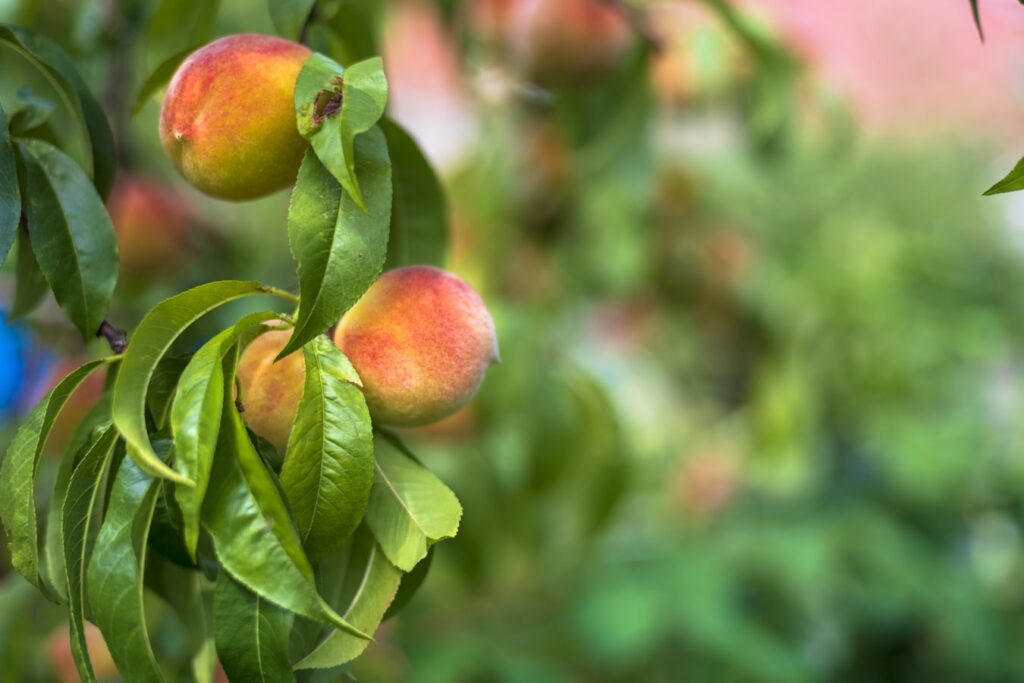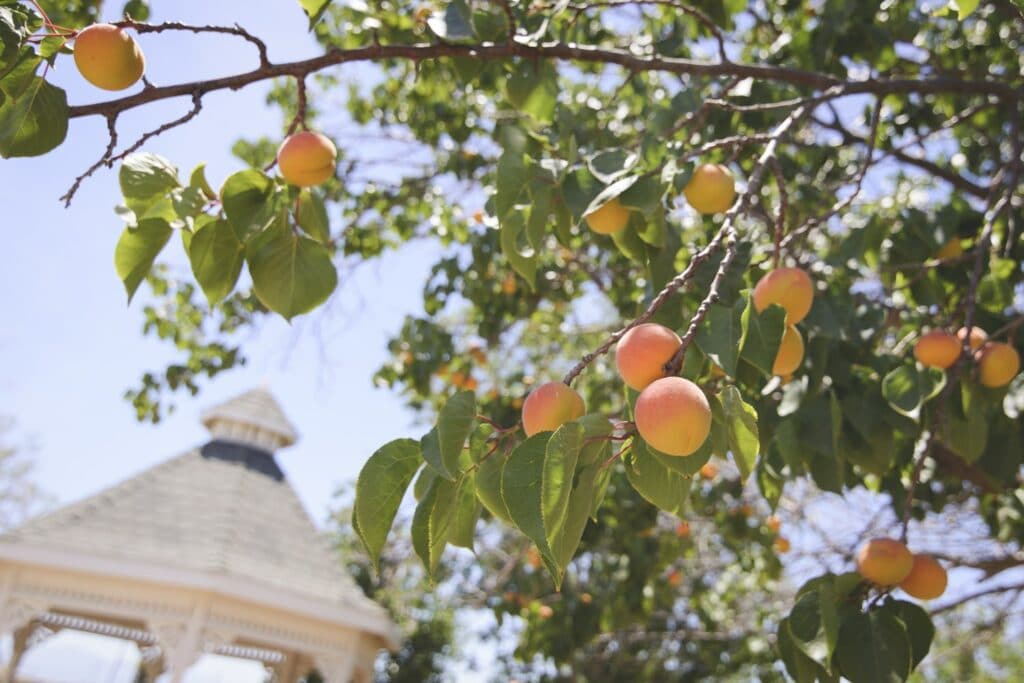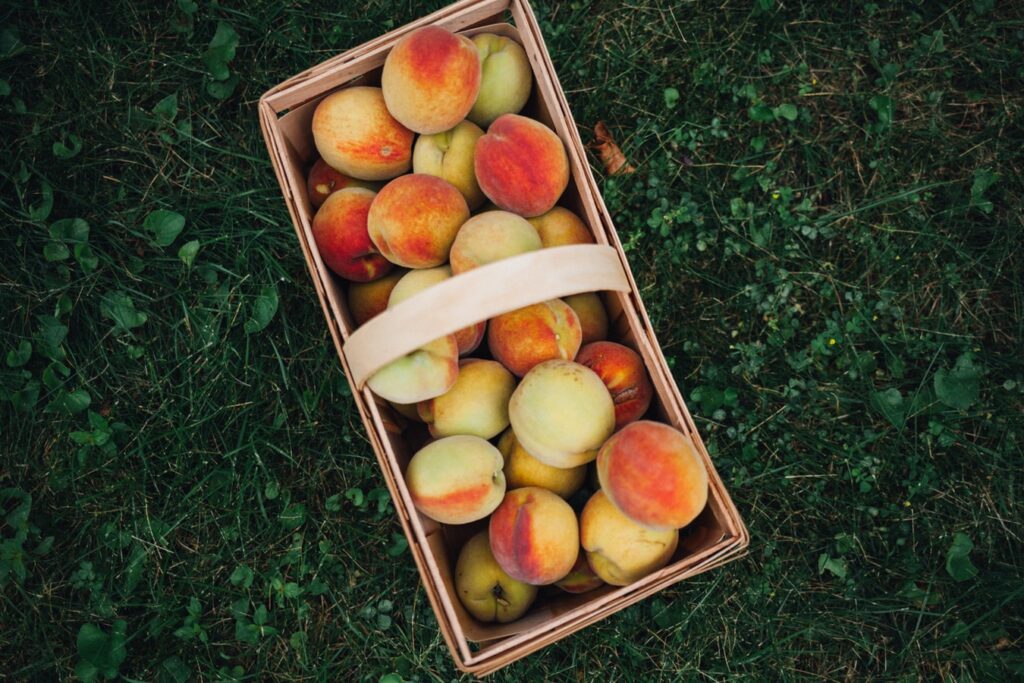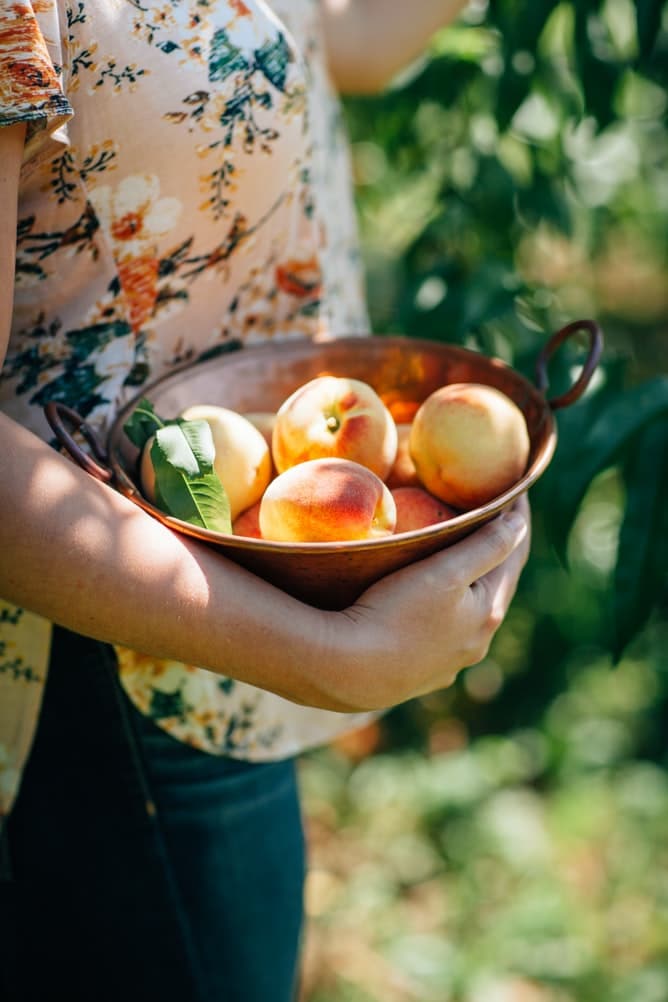Flower Glossary is reader-supported. When you buy through links on our site, we may earn an affiliate commission.
Peach trees (prunus persica) will reach about 25 feet when they reach full maturity. But, getting them there takes the right tools, plenty of tender, loving, care, and a little know-how on the part of the grower.
According to the Environmental Working Group, peaches are among the most pesticide-laden fruits when purchased at your everyday supermarket. For this reason, if you are a peach lover, it may make all the sense in the world to grow your own. You can do this right in the backyard, where you can ensure that what you are getting is a completely natural, pesticide-free, and organic end product. And, in even better news, if you don’t have space for a 25-foot behemoth peach tree, that’s okay. You can opt to plant a dwarf peach tree, which only reaches about four to six feet in height instead.
If you’re ready to take on the task of growing your own peach tree, or even a peach tree orchard, here’s what you need to know to get started.

Table of Contents
Peach Tree Varieties and Options for Growing
As we have already stated, the largest peach tree species will grow to be about 25 feet in height. And, dwarf peach trees will grow to be about four to six feet in height. But, if you have very little space to work with, or even if you don’t have a yard, you can still grow your own peach trees. This can be accomplished by planting a species perfect for a planter box or round container.
With all of these different options, there is nothing stopping you now from enjoying everything peaches have to offer. From fresh peaches to peach pie, and from peach jam and preserves to preparing your own dehydrated peach strips, growing your own offers a true bounty of options.
The Soil You Will Need
Whether you’re growing from your backyard, in an orchard, or from a planter box, if you plan on growing organic peach trees, you must consider the soil. As with many other fruit-bearing trees, peach trees require a soil type that will allow the roots of the tree to properly drain. This means you will need a soil type that tends more toward the sandier side, and that will allow proper drainage to occur.
Next, you will need to consider adding a secondary soil type that will assist in the suppression of weeds and that will also ensure a soil that is overall on the acidic side. For this, you can consider either a wetter mulch type soil, or you can use something akin to leaf mold or even your own compost. This secondary layer will also keep the contents of the total soil contents healthier, making it likelier that your peach trees grow tall, strong, and fruitfully — literally.

Fertilizers You Should Consider for Seedling Peach Tree Growth
To ensure healthy and proper growth from the get-go, you’ll want to apply a balanced 10-10-10 fertilizer to your new peach trees every spring. So, what is a 10-10-10 fertilizer? Basically, it is a fertilizer that contains 10 percent phosphate, 10 percent nitrogen, and 10 percent potash. It is this mixture when used in spring, that will ensure that your peach trees obtain and maintain the nutrients they need to grow their strongest.
If you are unsure as to whether your soil is 10-10-10, look at the label first. If it does not mention a 10-10-10 mixed fertilizer, check the bag’s ingredients. If it does not mention 10 percent of phosphate, nitrogen, and potash, look for another mixed fertilizer that does.
When applying your 10-10-10 mixture each spring, you’ll want to start by using a pound for new and seedling trees. Every yearly spring thereafter, add another pound of the 10-10-10 mixture per year to the pot or base of each individual peach tree. In other words, in year two, you would add two pounds of 10-10-10 mix, year five you would add five pounds of 10-10-10, and so on.
Maintain this practice until you reach 10 pounds on the tenth year. There is no need to exceed this amount of phosphate, nitrogen, and potash mixed soil for fully grown, mature peach trees.
The Kind of Light Exposure Peach Trees Need
Peach trees are highly dependent on a good deal of strong sun exposure. If you set them to grow in the shade, they may blossom and flower, but eventually, they will lose their strength and begin to wilt. This could lead either to death or to simply not producing fruit.
Potting them or planting them in full sunlight will also help to ensure that they do not become infested with unwanted pests. Peach trees planted in high shade areas are known to experience issues with all manner of pests, as well as disease that will ultimately cost you the entire tree. And no one wants to work hard on growing only to have to chop down their tree(s) later.
For these reasons, we highly recommend potting or planting in an area of your yard or home that gets the most amount of sunlight. You want the tree(s) to receive as much sunlight throughout the day and as far into the evening as possible. This is especially important during the spring and summer months.
How to Water Your Peach Trees
Just as with many other fruit-bearing trees, peach trees also require a soil that maintains an even level of moisture. To accomplish this, you will want to begin by planting in moist, mixed soil, as discussed above. But beyond this, at first, you will need to check your soil every single day to ensure even, level moisture levels.
Once you have observed that soil maintains its moisture without being watered until a second or third day, you can stop watching so closely. At this point, you will know how often watering is required, and this will allow you to only need to check in once every two to three days. With this said, however, you’ll want to renew your close watch during the warmer months. This is because the warmer days tend to leach more moisture from the soil due to higher temperatures, especially outdoors. And, if you live in an already arid part of the world, you may want to monitor a little more closely every single day anyway.
If you stay the course the first two years by ensuring proper watering, your peach trees are far likelier to be sturdy from the jump. This will make them more prone to bearing beautiful, delicious peaches.
The Temperature and Humidity to Maintain for Ideal Peach Tree Growth
Peach trees prefer to be grown in USDA growing zones five through eight. For those who are not aware, here is a breakdown of those areas:
| USDA Zone 5 | Alaska, California, Colorado, Connecticut Idaho, Illinois, Indiana, Iowa, Kansas, Maine, Maryland, Massachusetts, Michigan, Minnesota, Missouri, Montana, Nebraska, Nevada, New Hampshire, New Mexico, New York, Ohio, Oregon, Pennsylvania, South Dakota, Utah, Vermont, Virginia Washington, West Virginia, Wisconsin, Wyoming |
| USDA Zone 6 | Alaska, Arizona, Arkansas, California, Colorado, Connecticut, District of Columbia, Georgia, Idaho Illinois, Indiana, Iowa, Kansas, Kentucky, Maine, Maryland, Massachusetts, Michigan, Missouri, Montana, Nevada, New Hampshire, New Jersey, New Mexico, New York, North Carolina, Ohio, Oklahoma, Oregon, Pennsylvania, Rhode Island, Tennessee, Texas, Utah, Virginia, Washington, West Virginia, Wyoming |
| USDA Zone 7 | Alabama, Alaska, Arizona, Arkansas, California, Colorado, Connecticut, Delaware, Georgia, Idaho, Maryland, Massachusetts, Mississippi, Missouri, Nevada, New Jersey, New Mexico, New York, North Carolina, Oklahoma, Oregon, Pennsylvania, Rhode Island, South Carolina, Tennessee, Texas, Utah, Washington |
| USDA Zone 8 | Alabama, Arizona, Arkansas, California, Florida, Georgia, Louisiana, Maryland, Mississippi, Nevada, New Mexico, North Carolina, Oklahoma, Oregon, South Carolina, Tennessee, Texas, Utah, Virginia, Washington, Washington, D.C. |
As you can see, some states fall into more than one USDA grow zone. This is because of the variations in the conditions of the climates in these areas. As one example, Alaska spans all eight zones that exist because its various regions offer conditions appropriate for nearly all minimum average temperatures.
What’s more, each USDA zone is also broken down by letter. For example, there is a USDA zone 5a, 5b, 5c, and so on. To be doubly sure your peach trees will grow well, you can simply find which zone letter the area of your state falls under. From here, you will look up the average minimum temperature. As long as your area does not fall below -20 degrees Fahrenheit, you should be able to grow peach trees without an issue.
But, even if your state does not appear here, don’t worry. You still have the option to grow inside your home, use a greenhouse, or even consider hydroponic indoor growth for your peach trees.
Harvesting Your Peach Trees
Finally, one day, the time will arrive for you to harvest peaches from your peach tree(s). We say finally because it will take about three to four years for your peach trees to become fruitful. However, in the grand scheme of things, and compared to other fruit-bearing trees, this is not that long.
You will know it is almost time to harvest in the third or fourth year when you first see the trees’ light pink blossoms in spring. Once these appear, you will begin to notice scads of teensy green peaches as summer approaches. At this time, you will need to prepare to thin your crop of peaches. If you skip this step, you will sadly be left with little more than a whole lot of peach pit-sized peaches at full growth.
To thin your crop, remove all peaches growing on the branches, except for the very largest ones. This will be visually obvious, and you will, over time, learn to trust your gut as to which peaches are simply too small to make the cut. Another good rule of thumb is to leave about six or so inches between each peach you leave on the branch. This will ensure that they have the space and resources from the tree to properly grow all the way through to maturity.
Pruning Your Peach Trees
As a last word of advice, pruning is a critical part of the peach tree-growing process. At first, it will seem strange and even wrong or offputting to have to cut perfectly healthy branches off of a beautiful tree. But, this important step ensures that your peach trees will obtain all the light they need to properly grow their fruit to maturity.
When you have completed the pruning process, the peach tree should have what some planters refer to as a herringbone pattern. This simply means the branches left should criss-cross one another from the base of the branches all the way to the top of the tree.
Pruning should always take place in July, regardless of where you reside or grow your trees, even if in a grow house or indoors. To begin, you’ll remove the most upright shoots closest to the interior part of the growth (as these are the ones that most shade the fruit). Continue to prune until all flowering branches receive as much light as possible. To best determine this, try pruning during the brightest part of the day wherever you live and grow your peach trees.
For the bold grower, peach tree husbandry can be quite rewarding, even if it does require great patience. Contrary to what you may have gleaned from reading this article, peach trees are quite hearty, though they do require your attention and time. The end reward is quite literally delicious, and you’ll never regret the time and work you put into growing peach trees!


